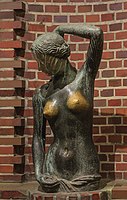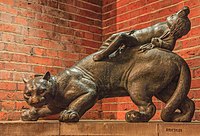Bernhard Hoetger


Bernhard Hoetger (4 May 1874 in
Life
Hoetger was the son of a Dortmund blacksmith, he studied sculpture in Detmold from 1888 to 1892, before directing a workshop in Rheda-Wiedenbrück. After a spell at the Düsseldorf Arts Academy, he took a trip to Paris, where he was deeply influenced by Auguste Rodin, but also got to know Paula Modersohn-Becker. Later he was able to familiarise himself with Antoni Gaudí. In 1911, Hoetger was called up to the Darmstadt Artists' Colony, where he was to remain for some time.
Böttcherstraße
In 1914, inspired by Modersohn-Becker, he moved to
HAG-TURM
He also designed the HAG-TURM, a building sponsored by Roselius's firm Kaffee HAG at the 1928
Nazi party links
Although Roselius was an ardent supporter of Nazism, Hitler denounced the art and architecture in the Boettcherstrasse. Roselius contemplated suicide, but his secretary
-
The "Niedersachsenstein" in Worpswede, Germany.
-
Lion Gate at Darmstadt (with Albin Müller)
-
Jugend (Youth) Torso in Bremen, Böttcherstraße
-
Sculpture "Puma carrying the Day" in Bremen, Böttcherstraße
References
- ^ "Haus Atlantis" (in German). Böttcherstraße GmbH. Archived from the original on 3 February 2014. Retrieved 28 January 2014.
- ^ "1919: Bernhard Hoetger". Deutscher Werkbund (in German). Archived from the original on 2017-04-15. Retrieved 15 April 2017.
- ^ a b HAG-TURM auf der Pressa. Kaffee Hag. 1928.
- ^ Margarita Tupitsyn; Matthew Drutt; El Lissitzky; Ulrich Pohlmann. El Lissitzky: Beyond the Abstract Cabinet: Photography, Design, Collaboration. p. 54.
- ^ Milau, Gerhard Ludwig (1928). "A World-wide Campaign for Selling Coffee". Commercial Art. V: 244–261. Archived from the original on 16 April 2017. Retrieved 15 April 2017.
- ISBN 978-1-62516-346-2
External links
 Media related to Bernhard Hoetger at Wikimedia Commons
Media related to Bernhard Hoetger at Wikimedia Commons- Bernhard Hoetger in the German National Library catalogue




